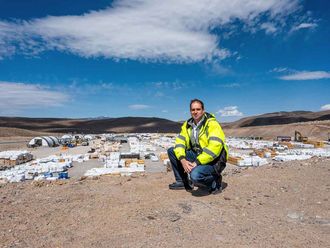The recent NFL Super Bowl held in Arizona was not only memorable for the incredible late comeback of the New England Patriots, but also for the hundreds of drones that formed a lighted canopy over Lady Gaga during her half-time show.
And with an audience of over one hundred million people watching, it’s clear that the subject of drones remains as topical as ever.
Drone technology has generated a lot of interest from the general public in recent years, as well as some uneasiness among the world’s aviation and security authorities. While the layman might look at a premium drone and see an expensive toy or perhaps a device that piques their photographic interests, the more tech-savvy end users among us see endless possibilities.
Of the numerous concerns sparked by drones, perhaps the most common relate to issues of privacy and security. These concerns were brought into the limelight here in the UAE when the unscrupulous use of drones forced the temporary closure of Dubai International Airport in both in both 2015 and 2016, causing losses that ran into the millions of dirhams.
Close encounters between aeroplanes and drones have also caused considerable concern worldwide over the threat they pose to aircraft and public safety. But while drones may have received some rather unsavory coverage due to such incidents (and more), there can be no denying the vast potential of the technology and its ability to transform a wide variety of traditional business processes.
The UAE has undoubtedly taken a lead in developing use cases for drone technology in the Middle East. And the country has also been at the forefront when it comes to establishing a set of rules that govern the use of drones by hobbyists and commercial users alike. For example, the Dubai Civil Aviation Authority has put in place procedures for securing a drone license in the emirate, while various no-fly zones have also been established.
Meanwhile, initiatives such as the UAE Drones for Good Award are helping to lay the foundations for drone innovation that meets the specific needs of the Middle East. However, the concerned bodies must be ready to constantly update regulation as new use cases emerge, and also be prepared to maintain regular dialogue with end users on the best ways to drive adoption of a technology that is likely to be more efficient, cost effective, and flexible than any pre-existing methods for accomplishing the same task.
Drones are rapidly replacing helicopters as the go-to choice for aerial video and photography, but they are also gaining traction across a whole host of other sectors where they offer a significantly cheaper and more accessible means to accomplishing a particular task. For instance, there has been strong adoption of drone use in the security and surveillance sector.
Drones are increasingly being used to surveil areas of interest where the use of manpower would ordinarily prove either too expensive or dangerous. Examples include large multinationals using drones to surveil oil pipelines here in the Middle East, and insurance companies in the US testing the use of drones for assisting the claim validation process by assessing roof damage.
Drones are also being used in the agricultural sector to capture accurate, high-definition images of farms and plantations. Furthermore, a combination of software and sensors are being developed and implemented wherein topology, drainage, and even crop health may be assessed through routine flyovers, thereby significantly reducing the need for manpower.
It must be stated that all these use cases are just the fruits of a technology that is still very much in its infancy, but one area that is likely to dominate in the future is drone delivery. Online retailer and home-delivery giant Amazon is one notable heavy investor in this space, while 7-Eleven — the world’s largest convenience store chain — has already made dozens of deliveries to customers using drones during tests carried out toward the end of last year.
From a commercial standpoint, such services are likely to impact hundreds of millions of customers over the long term, with consumers and businesses benefiting from almost instantaneous access to their documents or purchases. But drone delivery could also have a major role to play in improving health care, with first aid, organs, or even defibrillators being transported across large areas much more quickly than was previously possible.
Another intriguing use case for the future includes the potential for drones to expedite reforestation through precision mapping and planting. And when extended to farming, not only would the technology prove more efficient, but yield could also be increased by drones spraying exact quantities of fertilisers and pesticides.
The potential of drones is indeed endless, particularly as both the hardware and related software continue to advance at such a rapid rate. And with last year’s UAE Drones for Good Award winner being a reconnaissance drone capable of diving underwater, it would appear that not even the sky is the limit for their use.
— The columnist is group vice-president and regional managing director for the Middle East, Africa and Turkey at global ICT market intelligence and advisory firm International Data Corporation (IDC) He can be contacted via Twitter @JyotiIDC












